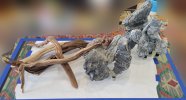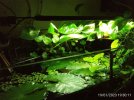Hi all,
I'm in the process of setting up a 44 gallon tank (90cm x 45cm x 45cm / ~36" x 18" x 18") and would love to stock some apistos. I was hoping to do blue rams, but their ideal temperature range is above my preference of 70-80F.
Tank will be heavily planted and hardscape is Manzanita wood and Seiryu stone (probably the Chinese equivalent) which I've glued together with aquascape epoxy to create caves underneath with tall "peaks" to block lines of sight. I realize Seiryu stone is limestone and will increase carbonate hardness if not treated. I plan to coat the structures with Polygem 1618 clear epoxy sealant. I also have some river rocks I've collected and cleaned (mostly granite and non-reactive to acid) I plan to include.
My tap water is of very good quality and comes out of the tap at about 50ppm. For my existing tanks I use a RO filter and re-mineralize with KH buffer and Salty Shrimp GH+.
I'd like to set this up as a community tank with the apistos as the centerpiece fish. I was intially thinking two pairs of different species, but I've seen conflicting information on whether that would be a good idea. I also have a honey gourami I might relocate to this tank, and might add a few sparkling gouramis. For schooling fish I'm thinking rummy nose tetras, black neon tetras, and/or some smaller rainbowfish.
What should I look into as far as numbers of apistos, species, and ratio of males/females? I'd love to keep two different varieties in there if possible, but I'd also be open to keeping 2-3 of the same species.
Thanks!
I'm in the process of setting up a 44 gallon tank (90cm x 45cm x 45cm / ~36" x 18" x 18") and would love to stock some apistos. I was hoping to do blue rams, but their ideal temperature range is above my preference of 70-80F.
Tank will be heavily planted and hardscape is Manzanita wood and Seiryu stone (probably the Chinese equivalent) which I've glued together with aquascape epoxy to create caves underneath with tall "peaks" to block lines of sight. I realize Seiryu stone is limestone and will increase carbonate hardness if not treated. I plan to coat the structures with Polygem 1618 clear epoxy sealant. I also have some river rocks I've collected and cleaned (mostly granite and non-reactive to acid) I plan to include.
My tap water is of very good quality and comes out of the tap at about 50ppm. For my existing tanks I use a RO filter and re-mineralize with KH buffer and Salty Shrimp GH+.
I'd like to set this up as a community tank with the apistos as the centerpiece fish. I was intially thinking two pairs of different species, but I've seen conflicting information on whether that would be a good idea. I also have a honey gourami I might relocate to this tank, and might add a few sparkling gouramis. For schooling fish I'm thinking rummy nose tetras, black neon tetras, and/or some smaller rainbowfish.
What should I look into as far as numbers of apistos, species, and ratio of males/females? I'd love to keep two different varieties in there if possible, but I'd also be open to keeping 2-3 of the same species.
Thanks!

